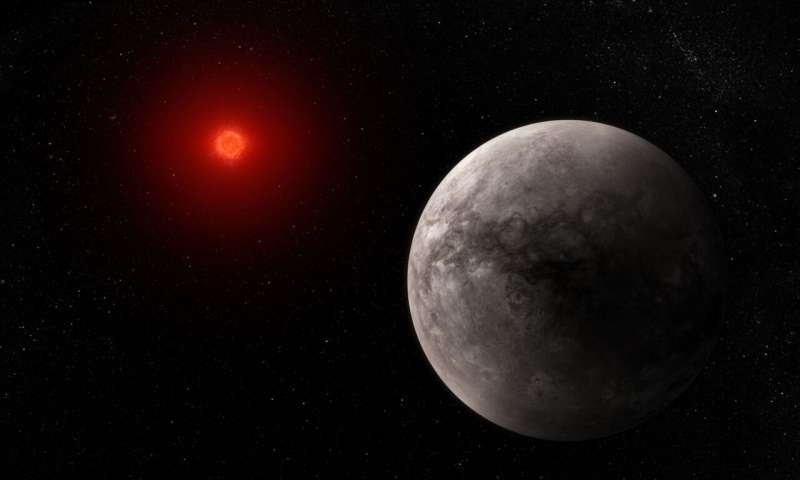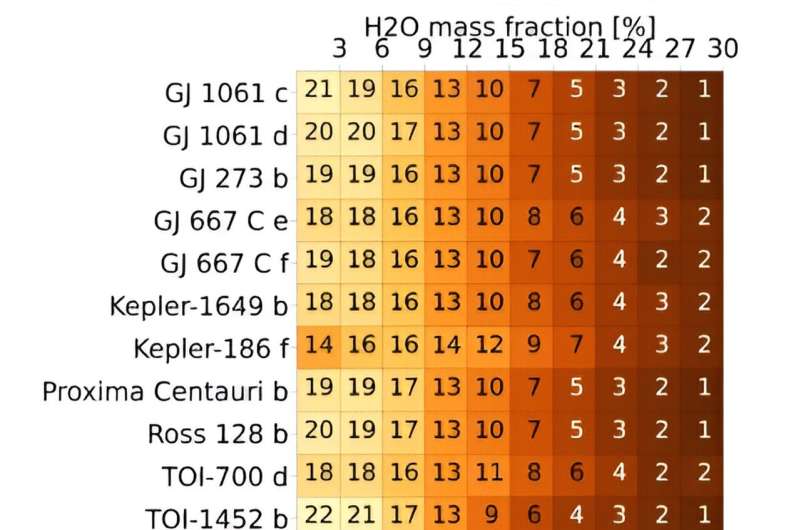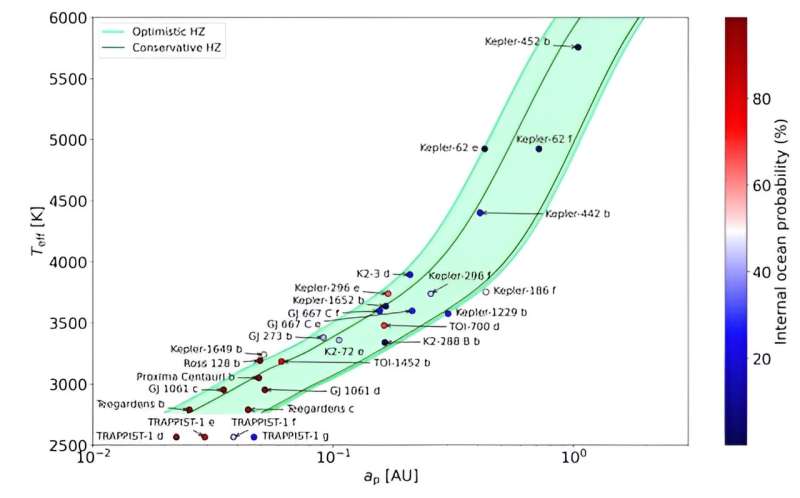This article has been reviewed according to Science X's editorial process and policies. Editors have highlighted the following attributes while ensuring the content's credibility:
fact-checked
preprint
trusted source
proofread
Astronomers calculate which exoplanets are most likely to have water

Astronomers know of about 60 rocky exoplanets orbiting in the habitable zones of their stars. When they try to determine how habitable these planets might be, detecting water in their atmospheres plays a huge role. But what if there was another way of measuring the water content in these worlds?
Researchers are developing a way of modeling these worlds to determine how much water they have.
Habitability likely requires surface water, as far as we can tell. But detecting surface water is next to impossible. The next best thing is to use the tools we have—like the James Webb Space Telescope—to detect and characterize exoplanet atmospheres. But despite the JWST's power, it can't examine every exoplanet atmosphere. Some are beyond its reach. But one team of researchers is using what we do know about exoplanets, tidal heating, and radiogenic heating to try to determine which exoplanets might have oceans, either on the surface or under the surface.
The team of scientists examined the list of rocky exoplanets in habitable zones and used modeling to determine how likely it is that they have a thick, surface or subsurface ocean layer. They published their results on the pre-print server arXiv in a paper titled "Water content of rocky exoplanets in the habitable zone." The lead author is Adam Boldog from the Konkoly Observatory and the HUN-REN Research Center for Astronomy and Earth Sciences in Budapest, Hungary.
One of the obstacles exoplanet scientists face is the proliferation of M-dwarf stars or red dwarfs. Half of the stars in the Milky Way might be red dwarfs, and that's where we've found most rocky planets in habitable zones. But red dwarfs exhibit significant flaring, and sometimes that flaring is far more powerful than anything our sun produces.
Since red dwarfs aren't as luminous as sun-like stars, their habitable zones are much closer to the star. That means that exoplanets in their habitable zones may have their atmospheres stripped away by the red dwarf's powerful flaring. Once the atmosphere is gone, surface water is sure to follow.
In those cases, the planet could still support life, even without atmospheres. It's possible that rocky planets in red dwarf habitable zones have lots of liquid water, just not on the surface. They could be more like our solar system's ocean moons Europa, Enceladus, and others. They have ample water, more than Earth in some cases. But they have no surface water and only extremely tenuous atmospheres. JWST's atmospheric spectroscopy can't tell us much about these types of worlds and if they have oceans.
"Therefore, it is important to explore other possible ways of studying the habitability of exoplanets that do not rely on the presence of an atmosphere," the authors explain.
"In this study, we investigated the interiors of rocky exoplanets in order to identify those that may have large quantities of water," the authors write. "We modeled the interiors of 28 rocky exoplanets, assuming four different layers—an iron core, a rock mantle, a high-pressure ice layer, and a surface ice/water layer."
Aside from a planet's structure, its heat budget plays a large role in its liquid water content. There are two ways a planet can generate heat. One is radiogenic heat that comes from the radioactive decay of isotopes of uranium, thorium, and potassium in the planet's mantle and crust. The other is tidal heating, which comes from the friction generated by a planet's orbit and rotation. The researchers included the likely amounts of both in their model.
"We estimated the probability of the presence of a thick ocean layer in these planets, taking into account the effect of both tidal and radiogenic heating," the authors explain.
Some of the planets in the study are well-known. Proxima Centauri b is the closest exoplanet to Earth, making it an object of intense speculation and study. The TRAPPIST-1 planets made headlines when they were discovered a few years ago. Others, including TOI 700d, are intriguing Earth-size exoplanets.
In their modeling, the researchers based the exoplanet structure on previous work showing that rocky exoplanets can have an iron core, a rocky mantle, a layer composed of high-pressure ice polymorphs (HPP), and a surface ice/water layer.
Based on the mass and radius of each planet, the researchers determined the water mass fractions for each of the 28 planets. This is a measure of how much of each planet's mass is water. The modeling arrived at a range of water mass fractions for each planet.
The input mass and sizes for some of the planets are more certain than others with the resulting H2O mass fractions concentrated in a relatively narrow range, with the H2O mass fractions showing a peak in the distribution at the largest probabilities.

"The color and the numbers indicate the fraction of all modeled interiors that resulted in internal structures within a certain H2O mass fraction range," the authors explain. "If a large number of interiors had high H2O mass fractions for a given planet, that appears as a shift in the values and lighter colors in the figure towards the higher mass fraction ranges."
The researchers found that all 28 of the planets in their sample could have global ice or water surfaces. Some of them don't even need atmospheres.
"Our results show that all of these planets could have large enough H2O mass fractions to have global ice/water surfaces," the researchers write. "Planets with surface temperatures above the melting point of ice and large water mass fractions may have global oceans regardless of the presence of an atmosphere."

Planets with surface temperatures below the melting point could still have water, according to the research, but it would be covered by ice. "If the internal heat flux in these bodies is sufficiently high to cause melting in the HPP layer, these worlds may harbor underground liquid water reservoirs," they explain.
Among the study's intriguing results are the TRAPPIST-1 planets. Since we have more accurate data for them than some of the other 28 planets in the study, the researchers say their results are more likely to be accurate. "All of the modeled TRAPPIST-1 planets are likely to have extended H2O layers," the authors explain, adding that the nature of those layers needs to be determined to assess habitability.
Some of the 28 planets have so much water that they may be ocean planets. In those cases, water vapor may provide enough atmospheric pressure to preserve surface oceans. "Our results suggest that Kepler-62 f, Kepler-452 b and Kepler-442 b could be members of the ocean-world class."
The study has some weak points, which the authors are quick to point out. For one thing, our understanding of radiogenic heating on worlds in other solar systems is based on a generalization from our solar system. There could be far more or far less radiogenic elements in rocky planets in other solar systems.
Tidal heating is similarly uncertain. "It is worth noting that tidal heating is strongly dependent on the eccentricity of the planetary orbit, which changes during the evolution of the planet," the authors explain. Planets on eccentric orbits experience tidal heating. But planets close to their stars eventually move toward circular orbits, which could eliminate that heat source.
If some of these results are correct, there may be more worlds with subsurface oceans than we think. Who knows? Maybe it's Earth that's the oddball.
"Subsurface oceans may be excellent sites for the development of life, although this may be difficult to observe with our current technology," the authors conclude.
Studies like this can't replace direct observation, but history shows how important they are in refining scientists' thinking. Though we can't observe these planets well enough to determine for certain if they have oceans or not, at least scientists can take what they do know and work toward an answer.
More information: Ádám Boldog et al, Water content of rocky exoplanets in the habitable zone, arXiv (2023). DOI: 10.48550/arxiv.2312.01893
Journal information: arXiv
Provided by Universe Today





















